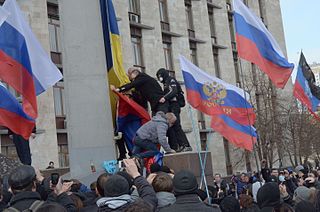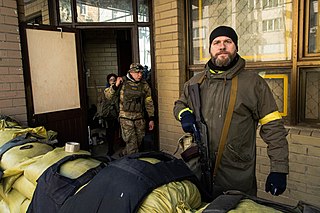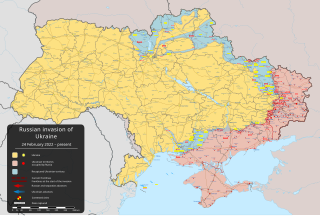
This is a list of historical regions in present-day Ukraine.

Carpathian Ruthenia is a historical region on the border between Central and Eastern Europe, mostly located in western Ukraine's Zakarpattia Oblast, with smaller parts in eastern Slovakia and the Lemko Region in Poland.

The Donbas or Donbass is a historical, cultural, and economic region in eastern Ukraine. Parts of the Donbas are occupied by Russia as a result of the Russo-Ukrainian War.

An oblast in Ukraine, sometimes translated as region or province, is the main type of first-level administrative division of the country. Ukraine's territory is divided into 24 oblasts, as well as one autonomous republic and two cities with special status. Ukraine is a unitary state, thus the oblasts do not have much legal scope of competence other than that which is established in the Ukrainian Constitution and devolved by law. Articles 140–146 of Chapter XI of the constitution deal directly with local authorities and their competence.

Eastern Ukraine or east Ukraine is primarily the territory of Ukraine east of the Dnipro river, particularly Kharkiv, Luhansk and Donetsk oblasts (provinces). Dnipropetrovsk and Zaporizhzhia oblasts are often also regarded as "eastern Ukraine". In regard to traditional territories, the area encompasses portions of the southern Sloboda Ukraine, Donbas, the eastern Azov Littoral (Pryazovia).

From the end of February 2014, demonstrations by Russian-backed, pro-Russian, and anti-government groups took place in major cities across the eastern and southern regions of Ukraine in the aftermath of the Euromaidan and the Revolution of Dignity, which resulted in the ousting of Russian-leaning President Viktor Yanukovych. The unrest, which was supported by Russian military and intelligence, belongs to the early stages of the Russo-Ukrainian War.

Pavel Yuryevich Gubarev is a Ukrainian-born Russian public figure, primarily known for his activities in Donbas in 2014.

The National Guard of Ukraine is the Ukrainian national gendarmerie and internal military force. It is part of the Ministry of Internal Affairs, responsible for public security. Originally created as an agency under the direct control of the Verkhovna Rada on 4 November 1991, following Ukrainian independence, it was later disbanded and merged into the Internal Troops of Ukraine in 2000 by then-President Leonid Kuchma as part of a "cost-saving" scheme. Following the 2014 Revolution of Dignity, amidst the Russian intervention, the National Guard was re-established, and the Internal Troops were disbanded.

This is a timeline of the 2014 pro-Russian unrest that has erupted in Ukraine, in the aftermath of the Ukrainian revolution and the Euromaidan movement.
Referendums on the status of Donetsk and Luhansk oblasts, parts of Ukraine that together make up the Donbas region, were claimed to have taken place on 11 May 2014 in many towns under the control of the Russian-controlled Donetsk and Luhansk People's Republics. These referendums intended to legitimise the establishment of the so-called "republics", in the context of the Russian invasion of Crimea and rising pro-Russian unrest in the aftermath of the 2014 Ukrainian Revolution. In addition, a counter-referendum on accession to Dnipropetrovsk Oblast was held in some Ukrainian-controlled parts of Donetsk and Luhansk oblasts.

The war in Donbas, or Donbas war was a phase of the Russo-Ukrainian War in the Donbas region of Ukraine. The war began in April 2014 when armed Russian-backed separatists seized government buildings and the Ukrainian military launched an operation against them. It continued until it was subsumed by the Russian invasion of Ukraine in February 2022.

The Luhansk People's Republic or Lugansk People's Republic is an internationally unrecognised republic of Russia in the occupied parts of eastern Ukraine's Luhansk Oblast, with its capital in Luhansk. The LPR was proclaimed by Russian-backed paramilitaries in 2014, and it initially operated as a breakaway state until it was annexed by Russia in 2022.
Novorossiya or New Russia, also referred to as the Union of People's Republics, was a project for a confederation between the self-proclaimed Donetsk People's Republic (DPR) and the Luhansk People's Republic (LPR) in Eastern Ukraine, both of which were under the control of pro-Russian separatists.

The 2nd Battalion of Special Assignment "Donbas" is a unit of the National Guard of Ukraine subordinated to the Ministry of Internal Affairs of Ukraine and based in Severodonetsk. Originally created in 2014 as a volunteer unit called the Donbas Battalion by Semen Semenchenko following the Russian occupation of Crimea and possible invasion of continental Ukraine. The formation of the unit started in the spring of 2014 during the 2014 pro-Russian unrest in Ukraine. The unit was initially formed as an independent force, but has been since fully integrated into the National Guard as the 2nd Special Purpose Battalion "Donbas" within the 15th Regiment of the National Guard.
A variety of social, economical, cultural, ethnic, and linguistic factors contributed to the sparking of unrest in eastern and southern Ukraine in 2014, and the subsequent eruption of the Russo-Ukrainian War, in the aftermath of the early 2014 Revolution of Dignity. Following Ukrainian independence from the Soviet Union in 1991, resurfacing historical and cultural divisions and a weak state structure hampered the development of a unified Ukrainian national identity.

Ukraine inherited its special forces (Spetsnaz) units from the remnants of the Soviet armed forces, GRU and KGB units. Ukraine now maintains its own Spetsnaz structure under the control of the Ministry of Internal Affairs and under the Ministry of Defence, while the Security Service of Ukraine maintains its own Spetsnaz force, the Alpha group. In 2016 the Special Operations Forces were created as an independent branch of the Armed Forces of Ukraine formed only by special forces units.
Pisky is an abandoned village in Pokrovsk Raion, Donetsk Oblast, eastern Ukraine. It is located about 10 kilometres (6.2 mi) northwest from the center of the administrative center of the oblast, Donetsk, and about two kilometres (1.2 mi) from the western border of Donetsk airfield. Before 2014, the village was a former wealthy suburb of Donetsk. It had a population of 2,160 in the 2001 census, but most residents left during the war in Donbas, with only 9 people remaining as of 2019. In 2022, the village came under Russian occupation following a battle.

The Special Police Forces is a Ukrainian volunteer corps of law enforcement units, part of the Ministry of Internal Affairs of Ukraine. It was originally created for prevention of criminal encroachment and defence of civil order on 15 April 2014, following the Russian invasion of Ukraine. During the ongoing war in Donbas, the forces of the Special Tasks Patrol Police have fought against pro-Russian separatists as a paramilitary force.

The Territorial Defence Forces are the military reserve component of the Armed Forces of Ukraine.

The following outline is provided as an overview of and topical guide to the Russo-Ukrainian War:
















